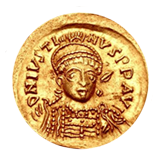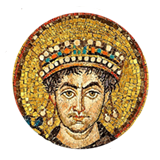
Emperor Justin I
Eastern Roman Emperor Justin I was born to a family of a peasant. He joined the military service of the palace guard. Being clever, strong, resilient, loyal and volitional fighter, he rose to the rank of military leader and was appointed head of the palace guard at the rank of comes and senator. In 518, after the death of childless Anastasius I, Justin became emperor, receiving support from the Guards, the Senate and Patriarch John I, who assured the Senate that the new emperor would follow the decisions of the Council of Chalcedon.
Justin I was born in the hamlet Baderiana rear Skopje. As he did not have children of his own, he invited to Constantinople his nephew Justinian, who later succeeded him as Emperor.
Read more
Emperor Justinian I
Justinian was well educated in jurisprudence, theology and Roman history. During Justin's reign, Justinian was the emperor's close confidant. As Justin became frail towards the end of his life, Justinian became de facto the ruler. In 521 was appointed consul, and later commander of the army. After Justin’s death in 527 Justinian became the sole emperor.
Justinian knew how to interact with people and was always surrounded by talented advisers and military leaders, however, decisions were always made by himself, which many in the Senate did not like. Justinian was very lucky to marry Theodora, who became one of the brightest figures in history, despite her common origin. Daughter of a zookeeper, a circus actress, a dancer and a courtesan, she had beauty, intelligence, a strong will and a craving for knowledge. Low origin largely determined her attitude to the court nobility. After her marriage to Justinian, she turned into a virtuous woman, and conducted correspondence, participated in theological disputes, reception of ambassadors and other public affairs.
Only once was the emperor's determination and firmness shaken - during Nika riots, when Justinian wanted to flee the capital. But he was chastened by his wife Theodora, who said: "Who wore the tiara once should not fear death, and purple makes the best shroud." The Emperor stayed in the capital.
After successfully crushing the Nika riot Justinian I began to strengthen its power. He decided to build in Constantinople the largest cathedral of Hagia Sophia on the place where the original church was burned down during the Nika riots. For this purpose, in 532 he invited the most famous architects of that time, who had experience in designing and building grand structures. They were Anthemius of Tralles and Isidore of Milet.
Read more
